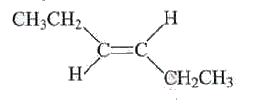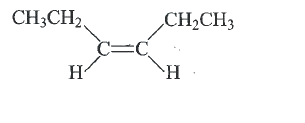In the reactions HC≡CH(1)NaNH2/liq.NH3−−−−−−−−−−−−−→(2)CH3CH2BrX
X(1)NaNH2/liq.NH3−−−−−−−−−−−−−→(2)CH3CH2BrY,X and Y are :
X = 1-Butyne, Y = 2-Hexyne
X = 1-Butyne, Y = 3-Hexyne
X = 2-Butyne, Y = 3-Hexyne
X = 2-Butyne, Y = 2-Hexyne
The correct Answer is:2
To solve the given problem, we will analyze the reactions step by step and identify the products X and Y formed in the reactions.
Step 1: Identify the Reactants
The first reactant is acetylene (HC≡CH), and the second reactant is ethyl bromide (CH₃CH₂Br). The reagent used is sodium amide (NaNH₂) in liquid ammonia (NH₃).
Step 2: Reaction of Acetylene with NaNH₂
When acetylene reacts with sodium amide in liquid ammonia, the acidic hydrogen from the terminal carbon of acetylene is removed by sodium amide. This results in the formation of a sodium acetylide intermediate.
Reaction:
HC≡CH+NaNH2→HC≡C−Na++NH3
Step 3: Nucleophilic Substitution with Ethyl Bromide
The sodium acetylide (HC≡C⁻) acts as a nucleophile and attacks the ethyl bromide (CH₃CH₂Br). The bromine atom is displaced, resulting in the formation of product X.
Reaction:
HC≡C−Na++CH3CH2Br→HC≡C-CH2CH3+NaBr
Step 4: Identify Product X
The product X formed from the above reaction is butyne (specifically 1-butyne, as the triple bond is at the terminal position).
Product X:
X=HC≡C-CH2CH3(1-butyne)
Step 5: Reaction of Product X with NaNH₂ Again
Now, product X (1-butyne) undergoes a similar reaction with sodium amide in liquid ammonia. The acidic hydrogen from the terminal carbon of 1-butyne is removed again, forming another sodium acetylide intermediate.
Reaction:
HC≡C-CH2CH3+NaNH2→HC≡C-CH2C−Na++NH3
Step 6: Nucleophilic Substitution with Ethyl Bromide Again
The new sodium acetylide (HC≡C-CH₂⁻) then reacts with another molecule of ethyl bromide (CH₃CH₂Br), resulting in the formation of product Y.
Reaction:
HC≡C-CH−2+CH3CH2Br→HC≡C-CH2CH2CH3+NaBr
Step 7: Identify Product Y
The product Y formed from this reaction is hexyne (specifically 3-hexyne, as the triple bond is between the third and fourth carbon).
Product Y:
Y=HC≡C-CH2CH2CH3(3-hexine)
Final Answer
Thus, the products X and Y are:
- X: 1-butyne (HC≡C-CH₂CH₃)
- Y: 3-hexyne (HC≡C-CH₂CH₂CH₃)
---
The first reactant is acetylene (HC≡CH), and the second reactant is ethyl bromide (CH₃CH₂Br). The reagent used is sodium amide (NaNH₂) in liquid ammonia (NH₃).
When acetylene reacts with sodium amide in liquid ammonia, the acidic hydrogen from the terminal carbon of acetylene is removed by sodium amide. This results in the formation of a sodium acetylide intermediate.
HC≡CH+NaNH2→HC≡C−Na++NH3
The sodium acetylide (HC≡C⁻) acts as a nucleophile and attacks the ethyl bromide (CH₃CH₂Br). The bromine atom is displaced, resulting in the formation of product X.
HC≡C−Na++CH3CH2Br→HC≡C-CH2CH3+NaBr
The product X formed from the above reaction is butyne (specifically 1-butyne, as the triple bond is at the terminal position).
X=HC≡C-CH2CH3(1-butyne)
Now, product X (1-butyne) undergoes a similar reaction with sodium amide in liquid ammonia. The acidic hydrogen from the terminal carbon of 1-butyne is removed again, forming another sodium acetylide intermediate.
HC≡C-CH2CH3+NaNH2→HC≡C-CH2C−Na++NH3
The new sodium acetylide (HC≡C-CH₂⁻) then reacts with another molecule of ethyl bromide (CH₃CH₂Br), resulting in the formation of product Y.
HC≡C-CH−2+CH3CH2Br→HC≡C-CH2CH2CH3+NaBr
The product Y formed from this reaction is hexyne (specifically 3-hexyne, as the triple bond is between the third and fourth carbon).
Y=HC≡C-CH2CH2CH3(3-hexine)
Thus, the products X and Y are:
- X: 1-butyne (HC≡C-CH₂CH₃)
- Y: 3-hexyne (HC≡C-CH₂CH₂CH₃)
Topper's Solved these Questions
- HYDROCARBONSBOOK - AAKASH INSTITUTE ENGLISHCHAPTER - HYDROCARBONSEXERCISE - Assignment(Section - B) (Obejctive type question)
5 Videos
- HALOALKANES AND HALOARENES BOOK - AAKASH INSTITUTE ENGLISHCHAPTER - HALOALKANES AND HALOARENES EXERCISE - ASSIGNMENT SECTION -D
15 Videos
- HYDROGENBOOK - AAKASH INSTITUTE ENGLISHCHAPTER - HYDROGENEXERCISE - ASSIGNMENT (SECTION - D) (Assertion-Reason Type question)
15 Videos
Similar Questions
Knowledge Check
CH3CH2C≡ChNaNH2/NH3(l)−−−−−−−−−−→CH3CH2Br−−−−−−→Li,NH3(l)−−−−−−→
ACH3CH2CH=CH−CH3BCH3CH2CH=CH2C D
D
H3C−C≡CH1.NaNH2−−−−−−−→2.CH3CH2BrAH2−−−−−−→Pd−BaSO4B :
AA is H3C−CH2−C≡CHBA is CH3−C≡C−CH2CH3C D
D
In the given reaction CH3−CN+CH3CHONaNH2/NH3(l)−−−−−−−−−−→(X), (X) will be
View SolutionCH3−C≡C−HNaNH2−−−−→CH31−−→Li/Liq.NH3−−−−−−−→
View SolutionCH≡CHNaNH2−−−−→[A]CH3Br−−−→[B]
View SolutionThe product og trsvyion : CH3CH2OH+Cu300∘C−−−→ ?
View SolutionIdentify X and Y in the reaction.
CH3−CH∣CH3−CONH2Br2/NaOH−−−−−−→XHNO2−−−→Y
View SolutionComplete the following reactions:
a. Prop−1−yneNaNH2−−−−→liq.NH2(B)

View Solution

